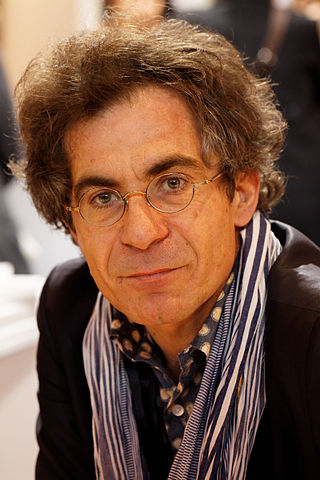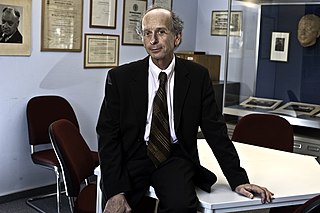
Louis Victor Pierre Raymond, 7th Duc de Broglie was a French aristocrat and physicist who made groundbreaking contributions to quantum theory. In his 1924 PhD thesis, he postulated the wave nature of electrons and suggested that all matter has wave properties. This concept is known as the de Broglie hypothesis, an example of wave–particle duality, and forms a central part of the theory of quantum mechanics.

The French National Centre for Scientific Research is the French state research organisation and is the largest fundamental science agency in Europe.

The French Alternative Energies and Atomic Energy Commission, or CEA, is a French public government-funded research organisation in the areas of energy, defense and security, information technologies and health technologies. The CEA maintains a cross-disciplinary culture of engineers and researchers, building on the synergies between fundamental and technological research.
Francis Perrin was a French physicist, who worked on nuclear physics, fission and neutrinos. He was the high-commissioner Commissariat à l'énergie atomique in France and a collaborator of CERN. He was involved in the development of nuclear weapons for France and the cooperation with Israel on nuclear research.
The French Institut de radioprotection et de sûreté nucléaire (IRSN) located in Fontenay-aux-Roses is a public official establishment with an industrial and commercial aspect (EPIC) created by the AFSSE Act and by February 22, 2002 decreed n°2002-254. The IRSN is placed under the conjoint authority of the Defence minister, the Environmental minister, the Industry minister and the Health and Research minister.
Jacques Villain was a French physicist. He received his PhD at the École normale supérieure, did research at the Institut Laue-Langevin in Grenoble, held, from 1984 to 1988, the position of a director at the Jülich Research Centre in Germany, and he was, since 1996, directeur des recherches at the Commissariat à l'énergie atomique. In the year 2000 he was elected as a member of the Académie des sciences.

EDELWEISS is a dark matter search experiment located at the Modane Underground Laboratory in France. The experiment uses cryogenic detectors, measuring both the phonon and ionization signals produced by particle interactions in germanium crystals. This technique allows nuclear recoils events to be distinguished from electron recoil events.

The CEA Paris-Saclay center is one of nine centers belonging to the French Alternative Energies and Atomic Energy Commission (CEA). Following a reorganization in 2017, the center consists of multiple sites, including the CEA Saclay site, the Fontenay-aux-Roses site and the sites of Paris, Évry, Orsay and Caen.
Jules Horowitz, a French physicist, was born on the 3rd of October 1921 in Rzeszów in Poland and died on the 3rd of August 1995 in the 7th arrondissement of Paris. The Jules Horowitz Reactor is named after him.

Étienne Klein is a French physicist and philosopher of science, born in 1958. A graduate of École Centrale Paris, he holds a DEA in theoretical physics, as well as a Ph.D. in philosophy of science and an accreditation to supervise research (HDR).

The idea that matter consists of smaller particles and that there exists a limited number of sorts of primary, smallest particles in nature has existed in natural philosophy at least since the 6th century BC. Such ideas gained physical credibility beginning in the 19th century, but the concept of "elementary particle" underwent some changes in its meaning: notably, modern physics no longer deems elementary particles indestructible. Even elementary particles can decay or collide destructively; they can cease to exist and create (other) particles in result.

Paris-Saclay University is a combined technological research institute and public research university in Orsay, France. Paris-Saclay was established in 2019 after the merger of four technical grandes écoles, as well as several technological institutes, engineering schools, and research facilities; giving it fifteen constituent colleges with over 48,000 students combined.
Jean Zinn-Justin is a French theoretical physicist.

Ursula Rita Bassler is a French-German particle physicist. Bassler was the President of the CERN Council from 2019 to 2021, and deputy director of National Institute of Nuclear and Particle Physics (IN2P3), CNRS, from 2014 to 2015.
Jean-Bernard Zuber is a French theoretical physicist.

Michel Spiro is a French physicist.
The prix Jaffé is a prize of the Institut de France awarded by nomination of the French Academy of Sciences. The award is financially supported by the Jaffé foundation of the institute.

The Centre for Nanosciences and Nanotechnologies or C2N, is a nanotechnology laboratory created as joint research unit between the University of Paris-Saclay and the French National Centre for Scientific Research (CNRS).
Vanina Ruhlmann-Kleider is a French physicist and director of research for the French National Centre for Scientific Research (CNRS), at CEA Paris-Saclay. Originally working in experimental particle physics, her interests shifted to observational cosmology through her participation in the Supernova Legacy Survey and Baryon Oscillation Spectroscopic Survey projects.
The Institute of Theoretical Physics (IPhT) is a research institute of the Direction of Fundamental Research (DRF) of the French Alternative Energies and Atomic Energy Commission (CEA). The Institute is also a joint research unit of the Institute of Physics (INP), a subsidiary of the French National Center for Scientific Research (CNRS). It is associated to the Paris-Saclay University. IPhT is situated on the Saclay Plateau South of Paris.











